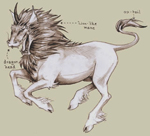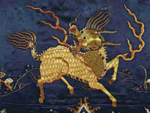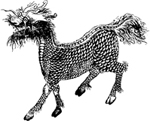
The Ki-Lin, also spelt Qilin, is a mythical Chinese creature said to appear in conjunction with the arrival of a sage, it is also thought to be a good omen that brings serenity and prosperity to which ever area it visits. The appearance of the Ki-Lin, even in a single country such as China, can vary greatly between regions. In the Ming dynasty of China, 1368 – 1644, the Ki-Lin is depicted as an ox hoofed animal with a dragon like head surmounted by a pair of horns and flame like head ornaments. In some representations the flames which come from the Ki-Lin’s mouth contain a book of Buddhist Sutras.  During the Qing dynasty 1644 – 1911, the Ki-Lin was a much more fanciful animal possessing the head of a dragon, the antlers of a deer, and skin and scales of a fish, the hooves of an ox and the tail of a lion. The Ki-Lin is even thought to have made its way to Japan where it was known as the Kirin, though this creature is depicted as being more horse like than the descriptions of its Chinese counterpart.
During the Qing dynasty 1644 – 1911, the Ki-Lin was a much more fanciful animal possessing the head of a dragon, the antlers of a deer, and skin and scales of a fish, the hooves of an ox and the tail of a lion. The Ki-Lin is even thought to have made its way to Japan where it was known as the Kirin, though this creature is depicted as being more horse like than the descriptions of its Chinese counterpart.
The Ki-Lin, though a fearsome beast was said to only punish or harm those that it deemed as wicked, the creature was able to walk on grass and not trample the blades and was even said to be able to walk on water. It took great care while walking about never to tread on any living thing and was said to appear only in areas ruled by a wise and benevolent leader or leaders. It is normally a very peaceful creature, but can become fierce if a pure person is threatened by a sinner, sprouting flames from its mouth and exercising other fearsome powers that can vary from story to story.  The origins of the Ki-Lin legend are unclear; one of the earliest known accounts of the creature came in 2697 BC when a Ki-Lin was reported to have roamed through the palace of Chinese emperor Huang-ti. It also appeared in the 5th century BC book Zuo Zhuan and made appearances in a variety of subsequent Chinese works of history and fiction. Over time, through these writings the Ki-Lin came to be identified with the giraffe.
The origins of the Ki-Lin legend are unclear; one of the earliest known accounts of the creature came in 2697 BC when a Ki-Lin was reported to have roamed through the palace of Chinese emperor Huang-ti. It also appeared in the 5th century BC book Zuo Zhuan and made appearances in a variety of subsequent Chinese works of history and fiction. Over time, through these writings the Ki-Lin came to be identified with the giraffe.
It is known that on Zheng He’s voyage to East Africa the fleet returned to Beijing with two giraffes from what is now Kenya. These two giraffes were referred to as Qilin which as previously stated is another name for the Ki-Lin. The emperor proclaimed the giraffes magical creatures whose capture signaled the greatness of his power.  The extent to which the giraffe and the Ki-Lin were regarded as the same creature in pre-modern times however is unclear, for example, Ming-era descriptions of the Ki-Lin clearly state it has a much shorter neck than a giraffe. Other theories state that the Ki-Lin may be a sub species of China’s Water Deer or that the Ki-Lin sighted in the Huang-ti palace may have been a single mutated deer which gained fame through world of mouth and started the entire legend. The truth is we may never know which, if any, of these theories are correct, and if a creature like the Ki-Lin ever did exist it may have gone extinct a long ago.
The extent to which the giraffe and the Ki-Lin were regarded as the same creature in pre-modern times however is unclear, for example, Ming-era descriptions of the Ki-Lin clearly state it has a much shorter neck than a giraffe. Other theories state that the Ki-Lin may be a sub species of China’s Water Deer or that the Ki-Lin sighted in the Huang-ti palace may have been a single mutated deer which gained fame through world of mouth and started the entire legend. The truth is we may never know which, if any, of these theories are correct, and if a creature like the Ki-Lin ever did exist it may have gone extinct a long ago.
The Evidence
No physical evidence of the Ki-Lin’s existence has been discovered to day.
The Sightings
The only documented sighting of the Ki-Lin occurred in 2697 BC when the animal reportedly walked through the palace of a Chinese emperor named Huang-ti
The Stats – (Where applicable)
• Classification: Hybrid
• Size: Varies from story to story
• Weight: Unknown
• Diet: Herbivore
• Location: China and Japan
• Movement: Four legged walking
• Environment: Unknown
|